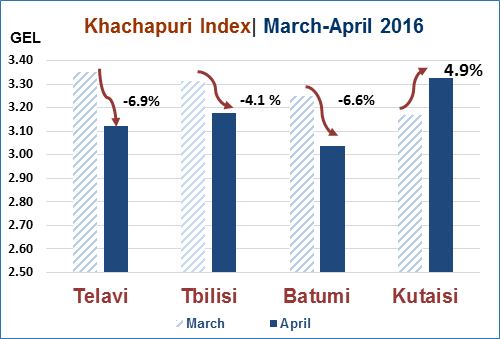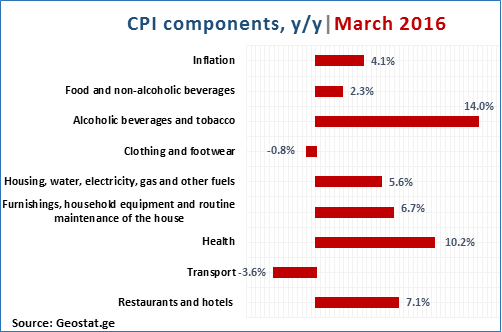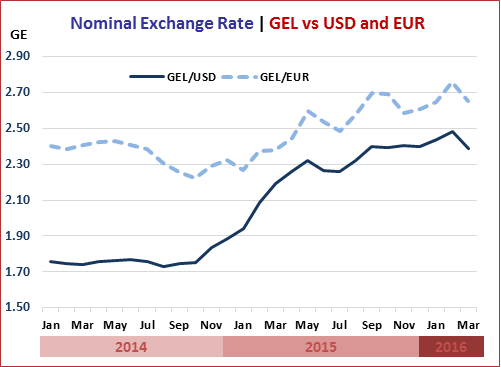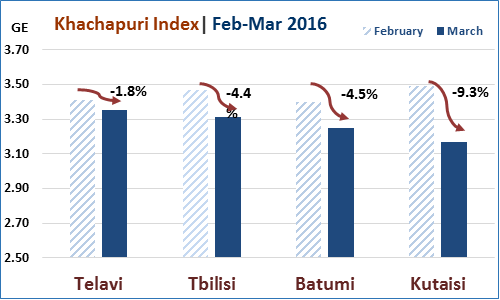- Details
Spring brings happiness in peoples’ lives not only because of the brighter days but also because the increased supply of many seasonal products. This is reflected in the production cost of Khachapuri. In April 2016, the national average cost of preparing one standard Imeretian khachapuri went down to 3.16 GEL, 3.2% lower compared to March 2016 (but 6.9% higher compared to April 2015).
In April, more cheese was brought to the market, leading to a decline of the Khachapuri price index in almost all surveyed cities. Compared to last month, in Telavi the index went down by 6.9%, in Batumi by 6.6%, and in Tbilisi by 4.1%. Surprisingly, only in Kutaisi, the home of Imeretian Khachapuri, the index went up by 4.9%. How can this be explained?
- Details
In March 2016, the average cost of cooking one standard Imeretian khachapuri declined to 3.27 GEL, which is 5% lower month-on-month (that is compared to February 2016), and 6.9% higher year-on-year (compared to March 2015).
The negative monthly change in Kh-Index follows the traditional seasonal trend in fresh milk production in combination with a temporary slump in demand due to the Great Fast of Lent, which started on March 14.
The annual increase in Kh-Index, however, reflects an uptick in annual price inflation. Practically all khachapuri ingredients (with the exception of flour, which dropped 5.1% y/y) went up in price compared to last year: cheese added 12.5%, eggs - 1.6%, milk - 4.3%, butter - 9%, and yeast - 8.6%. These increases are very much in line with the official estimate of annual inflation by GeoStat, currently standing at 4.1%. Just like the Khachapuri Index, in monthly terms, CPI inflation is actually in the negative territory (March CPI is down by 0.3% m/m).
- Details
In March 2016, the average cost of cooking one standard Imeretian Khachapuri stood at 3.27GEL, which is 5% lower month-on-month (m/m, that is compared to the previous month), but 6.9% higher year-on-year (y/y, that is compared to the same month of last year).
For foreign currency earners, however, the Khachapuri Index dropped both m/m and y/y.
Even though last month we saw the Georgian lari slightly appreciating against both USD and EUR, this appreciation was more than compensation for by the seasonal decline in the price of cheese (the main khachapuri ingredient).
In yearly comparison, the khachapuri, like many other Georgian products, is cheaper when valued in foreign currency thanks to the large y/y depreciation of the lari.
- Details
Spring is already here. Seeing more sunshine and rains, Georgia’s western provinces are enjoying the sharpest seasonal increases in the supply of fresh milk and dairy products, such as Imeretian cheese. This cheese is the main (and most expensive) component of the Georgian khachapuri, driving the sharp seasonal fluctuations of the Khachapuri Index.
In March 2016, the national average cost of cooking one standard Imeretian khachapuri declined to 3.27 GEL, which is 5% lower month-on-month (that is compared to February 2016) but 6.9% higher year-on-year (compared to March 2015). The y/y increase in the Khachaprui Index is roughly in line with the official estimates of annual CPI inflation by GeoStat.














